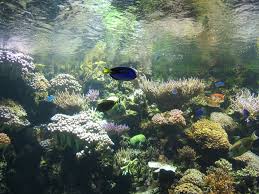Computer Background Images Biography
Global warming refers to the rising average temperature of Earth's atmosphere and oceans since the late 19th century, as well as its projected continuation. Since the early 20th century, Earth's mean surface temperature has increased by about 0.8 °C (1.4 °F), with about two-thirds of the increase occurring since 1980.Warming of the climate system is unequivocal, and scientists are more than 90% certain that it is primarily caused by increasing concentrations of greenhouse gases produced by human activities such as deforestation and the burning of fossil fuels. These findings are recognized by the national science academies of all major industrialized nations.
Climate model projections are summarized in the 2007 Fourth Assessment Report (AR4) by the Intergovernmental Panel on Climate Change (IPCC). They indicate that during the 21st century the global surface temperature is likely to rise a further 1.1 to 2.9 °C (2 to 5.2 °F) for their lowest emissions scenario and 2.4 to 6.4 °C (4.3 to 11.5 °F) for their highest. The ranges of these estimates arise from the use of models with differing sensitivity to greenhouse gas concentrations.
An increase in global temperature will cause sea levels to rise and will change the amount and pattern of precipitation, as well as cause a probable expansion of subtropical deserts. Warming is expected to be strongest in the Arctic and would be associated with the continuing retreat of glaciers, permafrost and sea ice. Other likely effects of the warming include a more frequent occurrence of extreme-weather events including heat waves, droughts and heavy rainfall, species extinctions due to shifting temperature regimes, and changes in crop yields. Warming and related changes will vary from region to region around the globe, with projections being more robust in some areas than others. If global mean temperature increases to 4 °C (7.2 °F) above preindustrial levels, the limits for human adaptation are likely to be exceeded in many parts of the world, while the limits of adaptation for natural systems would largely be exceeded throughout the world. Hence, the ecosystem services upon which human livelihoods depend would not be preserved.
Policy responses to global warming include mitigation by emissions reduction, adaptation to its effects, and possible future geoengineering. Most countries are parties to the United Nations Framework Convention on Climate Change (UNFCCC), whose ultimate objective is to prevent dangerous anthropogenic (i.e., human-induced) climate change. Parties to the UNFCCC have adopted a range of policies designed to reduce greenhouse gas emissions and to assist in adaptation to global warmin Parties to the UNFCCC have agreed that deep cuts in emissions are required, and that future global warming should be limited to below 2.0 °C (3.6 °F) relative to the pre-industrial level. A 2011 report of analyses by the United Nations Environment Programme and International Energy Agency suggest that efforts as of the early 21st century to reduce emissions may be inadequately stringent to meet the UNFCCC's 2 °C target.Evidence for warming of the climate system includes observed increases in global average air and ocean temperatures, widespread melting of snow and ice, and rising global average sea level.








Global warming refers to the rising average temperature of Earth's atmosphere and oceans since the late 19th century, as well as its projected continuation. Since the early 20th century, Earth's mean surface temperature has increased by about 0.8 °C (1.4 °F), with about two-thirds of the increase occurring since 1980.Warming of the climate system is unequivocal, and scientists are more than 90% certain that it is primarily caused by increasing concentrations of greenhouse gases produced by human activities such as deforestation and the burning of fossil fuels. These findings are recognized by the national science academies of all major industrialized nations.
Climate model projections are summarized in the 2007 Fourth Assessment Report (AR4) by the Intergovernmental Panel on Climate Change (IPCC). They indicate that during the 21st century the global surface temperature is likely to rise a further 1.1 to 2.9 °C (2 to 5.2 °F) for their lowest emissions scenario and 2.4 to 6.4 °C (4.3 to 11.5 °F) for their highest. The ranges of these estimates arise from the use of models with differing sensitivity to greenhouse gas concentrations.
An increase in global temperature will cause sea levels to rise and will change the amount and pattern of precipitation, as well as cause a probable expansion of subtropical deserts. Warming is expected to be strongest in the Arctic and would be associated with the continuing retreat of glaciers, permafrost and sea ice. Other likely effects of the warming include a more frequent occurrence of extreme-weather events including heat waves, droughts and heavy rainfall, species extinctions due to shifting temperature regimes, and changes in crop yields. Warming and related changes will vary from region to region around the globe, with projections being more robust in some areas than others. If global mean temperature increases to 4 °C (7.2 °F) above preindustrial levels, the limits for human adaptation are likely to be exceeded in many parts of the world, while the limits of adaptation for natural systems would largely be exceeded throughout the world. Hence, the ecosystem services upon which human livelihoods depend would not be preserved.
Policy responses to global warming include mitigation by emissions reduction, adaptation to its effects, and possible future geoengineering. Most countries are parties to the United Nations Framework Convention on Climate Change (UNFCCC), whose ultimate objective is to prevent dangerous anthropogenic (i.e., human-induced) climate change. Parties to the UNFCCC have adopted a range of policies designed to reduce greenhouse gas emissions and to assist in adaptation to global warmin Parties to the UNFCCC have agreed that deep cuts in emissions are required, and that future global warming should be limited to below 2.0 °C (3.6 °F) relative to the pre-industrial level. A 2011 report of analyses by the United Nations Environment Programme and International Energy Agency suggest that efforts as of the early 21st century to reduce emissions may be inadequately stringent to meet the UNFCCC's 2 °C target.Evidence for warming of the climate system includes observed increases in global average air and ocean temperatures, widespread melting of snow and ice, and rising global average sea level.
Computer Background Images
Computer Background Images
Computer Background Images
Computer Background Images
Computer Background Images
Computer Background Images
Computer Background Images
Computer Background Images
Computer Background Images
Photoshop Tutorial: Custom Abstract Desktop Wallpaper #2
Glass On Funky Computer Background
No comments:
Post a Comment